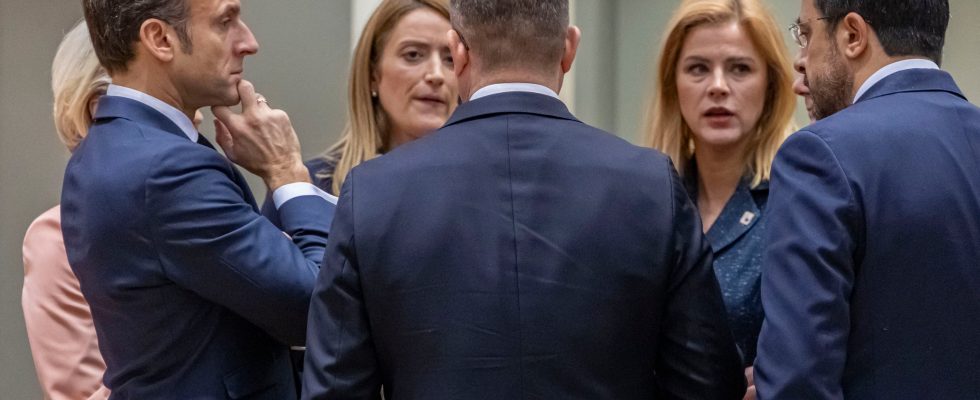An austere office building, at the corner of two large straight boulevards which cross the business district of Brussels. Large opaque smoked windows across the entire facade. On the top floor, the view is breathtaking over the rare species of the botanical garden and, in the distance, the jumble of the rails leading to the Gare du Nord. It is perhaps not in Bakhmout, Mariupol, or Donetsk that the outcome of the conflict in Ukraine is being played out, but in this tower of around fifteen floors which houses the headquarters of Euroclear, a little-known giant of the global finance. One of the largest clearing houses on the planet, a key player, a sort of safe and notary for all financial transactions. There, a good part of Vladimir Putin’s war chest is sleeping quietly, almost half of the approximately 300 billion dollars in reserves of the Central Bank of Russia. Fans of the Netflix series, The House of Paper, will be disappointed: no pyramids of gold bars or mountains of bank notes, just kilometers of digital writing and computer codes locked in tamper-proof servers. While the conflict is getting bogged down and Western financing of Ukraine is increasingly strained, particularly in the United States, many dream of getting their hands on this money to continue helping kyiv. A confiscation at the heart of a diplomatic game which could be resolved in the coming weeks.
To understand what is happening in Brussels, we have to go back to March 2022, a few days after Russian aggression in Ukraine. By mutual agreement, the United States, the European Union (EU) and their allies decide to freeze all reserves denominated in foreign currencies – dollars, euros, pounds and Swiss francs – of the Bank of Russia. Moscow remains the owner of its assets, but can no longer use them to finance its war effort or keep its economic machine running. Elvira Nabioullina, the very seasoned governor of the Bank of Russia, and one of the centerpieces of the Putin system, is taken by surprise. However, she had been preparing her move for months by reducing the share of dollar assets in the Russian treasury. Yes, Washington was inevitably going to act but Europe would not go that far… First misstep, all the more embarrassing for Moscow as the majority of its famous reserves are housed in Europe, notably at Euroclear. As soon as the announcement was made, many voices were raised to demand a real seizure, rather than a simple freeze. But Brussels is dragging its feet. Each set of sanctions is the subject of endless discussions among the 27 member states.
A shame. The more the months pass, the richer Russia becomes. Because the reserves, frozen, continue to bear fruit. According to our information, those entrusted to Euroclear brought in 4.4 billion euros in interest over the year 2023 and nearly 5 billion in total since the start of the war. A drop in the ocean compared to the hundreds of billions of euros that will be needed to rebuild Ukraine, but a good sum all the same.
Under pressure from the Baltic States, Poland and the United States, the European Commission agrees in early 2023 to set up a working group to think about how to use this treasure. A year later, on February 12, 2024, the EU presents a law paving the way for the use of profits from frozen assets. In detail, the European Commission would be responsible for transferring the money to the EU budget, then to Ukraine. Except that no precise timetable has been given for these operations.
A counterproductive operation?
Should we go further? And grab the whole cake? In 2021, Joe Biden unilaterally confiscated the reserves of the Bank of Afghanistan after the Taliban took power. Across the Atlantic, the pressure is increasing, especially as the prospect of a return to the White House of Donald Trump, hostile to any aid to Ukraine, is changing the situation. In France, deputies Julien Bayou (EELV) and Benjamin Haddad (LR) are preparing to present to the National Assembly a proposed transpartisan resolution to mobilize these frozen Russian assets. “Not doing everything in our power risks paying a very high price tomorrow. Now is the time to act, especially since Belgium, which currently chairs the Council of the EU, will give way in July next to Hungary, led by a significantly less energetic Viktor Orban”, argues Julien Bayou. Except that some in Europe – and first and foremost Christine Lagarde, the president of the European Central Bank – are putting on the brakes. Because this, they say, would endanger the reserve currency status of the euro. “Seizing Russian assets held in Europe risks weakening Western predominance in the global financial architecture and encouraging the creation of alternatives to Euroclear, for example in China,” underlines Agathe Demarais, geoeconomics specialist at European Council on Foreign Relations. For Cyrille Bret, associate researcher at the Jacques-Delors Institute, the tempo is not the right one: “Europe must keep ammunition, especially in the perspective of a Trump victory. Because it would find itself alone facing Putin and the future of these reserves would be a weapon in the discussions.”
Finally, two essential questions remain. Seize, yes, but for what? For some, this money should help finance the purchase of weapons for Ukraine. According to others, it must be used for the reconstruction of the country and compensation for war victims. Then, who should manage this treasure? The Ukrainian state or a European institution, such as the European Investment Bank (EIB) or the European Bank for Reconstruction and Development (EBRD)? Today, all options are on the table. But seen from kyiv, these quibbles are above all problems of countries at peace…
.
